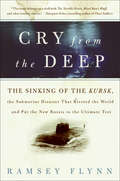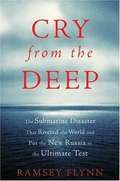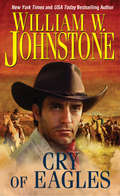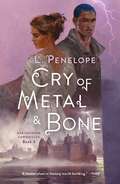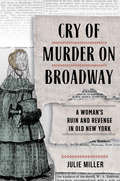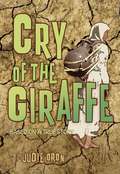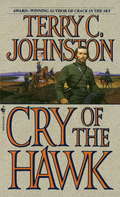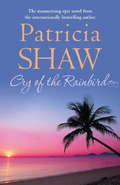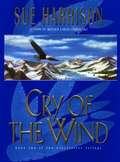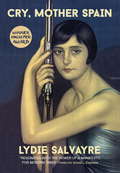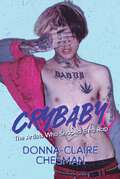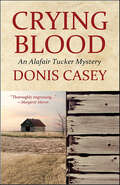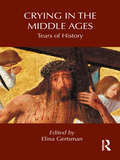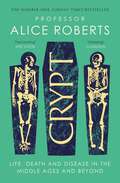- Table View
- List View
Cry Wolf
by Wilbur SmithAn action-packed adventure set in 1930s Africa from global bestseller Wilbur Smith“They recognised in each other that same restlessness that was always driving them on to new adventure, never staying long enough in one place or at one job to grow roots, unfettered by offspring or possessions, by spouse or responsibilities, taking up each new adventure eagerly and discarding it again with our qualms or regrets. Always moving onwards — never looking backwards.” The wartime race to save a country… When Jake Barton, American engineer, teams up with English gentleman and hustler Gareth Swales to sell five battered old Bentleys in 1930s East Africa, neither of them could have imagined that they’d soon be attempting to smuggle the vehicles into Ethiopia to support the war effort, in return for a huge reward. But to do this, they’ll have to manoeuvre past several extremely hostile European forces, as well as managing their feelings for Vicky Camberwell, the beautiful journalist who has been sent with them to report on the brutal violence of the Italian invasion of Ethiopia. The three adventurers are about to discover that some battles are more than they can handle…
Cry from the Deep: The Sinking of the Kursk
by Ramsey FlynnA “superb account” of the disastrous loss of a Russian submarine off the nation’s northern coast and its repercussions (Publishers Weekly).On August 12, 2000, during one of the most important military demonstrations in post-Soviet history, an enormous explosion sank Russia’s most prized nuclear submarine, the Kursk. When Vladmir Putin’s men failed to rescue the 118 young submariners trapped under the icy Barents Sea and refused timely help from “foreigners” for four days, the Russian president assured his angry nation that all the men had died within minutes of the blasts. An earlier rescue would not have changed anything.Two months later, recovery divers brought up the dead submarine’s first twelve bodies, one of which had a soggy note clinging to the burned remnants of his breast pocket. Addressed to his wife, it read:There are twenty-three of us here . . . None of us can get to the surface. Let's hope someone will read this. Don’t despair. —KolesnikovThe “Kolesnikov Note” became the cry from the depths of Russia’s tormented soul, as an anguished people confronted their government about what matters more—guarding secrets and pride or protecting human life.What were Russian officials thinking when they waited forty-eight hours to acknowledge that their most treasured submarine was in trouble? Why did they track the desperate tapping noises that seemed to be coming from the sub without sending an international SOS?For a world community still mystified by deadly Russian deceits surrounding the Kursk submarine disaster, Cry from the Deep solves the riddles once and for all. What emerges from Flynn’s exhaustive reporting is the definitive account of this pivotal moment in Russia’s rocky emergence into the community of free nations.By turns thrilling, heart-wrenching, and absorbing, Cry from the Deep exposes the truths behind an event that riveted the world, devastated and enraged the Russian people, and ultimately defined a new era of Russian politics.
Cry from the Deep: The Submarine Disaster That Riveted the World and Put the New Russia to the Ultimate Test
by Ramsey FlynnOn August 12, 2000, during one of the most important military demonstrations in post-Soviet history, an enormous explosion sank Russia's most prized nuclear submarine, the Kursk. When Vladmir Putin's men failed to rescue the 118 young submariners trapped under the icy Barents Sea and refused timely help from "foreigners" for four days, the Russian president assured his angry nation that all the men had died within minutes of the blasts. An earlier rescue would not have changed anything. Two months later, recovery divers brought up the dead submarine's first twelve bodies, one of which had a soggy note clinging to the burned remnants of his breast pocket. Addressed to his wife, it read: There are twenty-three of us here.... None of us can get to the surface. Let's hope someone will read this. Don't despair. -Kolesnikov The "Kolesnikov Note" became the cry from the depths of Russia's tormented soul, as an anguished people confronted their government about what matters more-guarding secrets and pride or protecting human life. What were Russian officials thinking when they waited forty-eight hours to acknowledge that their most treasured submarine was in trouble? Why did they track the desperate tapping noises that seemed to be coming from the sub without sending an international SOS?
Cry of Eagles (Eagles #7)
by William W. JohnstoneHe walks on his own—but trouble follows close behind—in this action-packed MacCallister Western by the USA Today bestselling author . . .Falcon MacCallister roams the West, far from home, far from the memories of the peace and beauty of MacCallister's Valley. With a destiny as wide and unsure as the open range, he is a loner. But to those who know him, he is a legend . . .In a small New Mexico town, two young gunslicks are looking for a reputation, eager for a kill, desperate for history to write their names in blood. In a split-second hook and draw, one of them will lie dead. And once again, Falcon MacCallister will be the most wanted man in the West. Now, from the Arizona border to the shadows of the Dragoon Mountains to the burning trail of Apache rage, he must fend off a ruthless posse that has sworn vengeance. Because a man like MacCallister knows: Between the final prayer and the snap of the rope there's no time for mercy.
Cry of Metal & Bone: Earthsinger Chronicles, Book 3 (Earthsinger Chronicles #3)
by L. PenelopeL. Penelope's stunning epic fantasy Earthsinger Chronicles continues with Cry of Metal & Bone.The Mantle dividing Elsira and Lagrimar has fallen. As the two kingdoms struggle to unify, one threat stands above them all.As desperate Lagrimari flee their barren land for a chance at a better life in Elsira, a shadowy group with ties to the Elsiran government launches an attack on their own soil. With threats of more violence, an unlikely crew is assembled to investigate. Among them are Lizvette Nirall, a disgraced socialite seeking redemption for past mistakes, and Tai Summerhawk, a foreign smuggler determined to keep a promise he made to a dead man. It’s a race against time in this world of deadly magic, secret agendas and court intrigue to discover those responsible before the next assault. And in another land a new enemy awakens—one that will strike terror into the hearts of gods and men.
Cry of Murder on Broadway: A Woman's Ruin and Revenge in Old New York
by Julie MillerIn Cry of Murder on Broadway, Julie Miller shows how a woman's desperate attempt at murder came to momentarily embody the anger and anxiety felt by many people at a time of economic and social upheaval and expanding expectations for equal rights.On the evening of November 1, 1843, a young household servant named Amelia Norman attacked Henry Ballard, a prosperous merchant, on the steps of the new and luxurious Astor House Hotel. Agitated and distraught, Norman had followed Ballard down Broadway before confronting him at the door to the hotel. Taking out a folding knife, she stabbed him, just missing his heart. Ballard survived the attack, and the trial that followed created a sensation. Newspapers in New York and beyond followed the case eagerly, and crowds filled the courtroom every day. The prominent author and abolitionist Lydia Maria Child championed Norman and later included her story in her fiction and her writing on women's rights. The would-be murderer also attracted the support of politicians, journalists, and legal and moral reformers who saw her story as a vehicle to change the law as it related to "seduction" and to advocate for the rights of workers. Cry of Murder on Broadway describes how New Yorkers, besotted with the drama of the courtroom and the lurid stories of the penny press, followed the trial for entertainment. Throughout all this, Norman gained the sympathy of New Yorkers, in particular the jury, which acquitted her in less than ten minutes. Miller deftly weaves together Norman's story to show how, in one violent moment, she expressed all the anger that the women of the emerging movement for women's rights would soon express in words.
Cry of the Giraffe
by Judie OronOne girl's harrowing trek from exile and slavery to hope in a new land -- all based on a true story. <p><p> In the early 1980s, thousands of Ethiopian Jews fled the civil unrest, famine and religious persecution of their native land in the hopes of being reunited in Jerusalem, their spiritual homeland, with its promises of a better life. Wuditu and her family risk their lives to make this journey, which leads them to a refugee camp in Sudan, where they are separated. <p><p>Terrified, 15-year-old Wuditu makes her way back to Ethiopia alone. "Don't give up, Wuditu! Be strong!" The words of her little sister come to Wuditu in a dream and give her the courage to keep going. Wuditu must find someone to give her food and shelter or she will surely die. Finally Wuditu is offered a solution: working as a servant. <p><p>However, she quickly realizes that she has become a slave. With nowhere else to go, she stays -- until the villagers discover that she is a falasha, a hated Jew. Only her dream of one day being reunited with her family gives her strength -- until the arrival of a stranger heralds hope and a new life in Israel. <p><p>With her graceful long neck, Wuditu is affectionately called "the giraffe." And like the giraffe who has no voice, she must suffer in silence. Based on real events, Wuditu's story mirrors the experiences of thousands of Ethiopian Jews.
Cry of the Hawk
by Terry C. JohnstonBestselling American frontier novelist Terry C. Johnston has created an extraordinary, authentic saga of war, loss, and human struggle. This masterwork captures the complex, bloody tapestry of a land of men unchecked by the law, of native warriors continually betrayed, and of ever-expanding railroads.
Cry of the Rain Bird: A mesmerising Australian saga of love, intrigue and betrayal
by Patricia ShawThe golden shores of Trinity Bay might not be the paradise they dream of... Patricia Shaw's Cry of the Rain Bird is an absorbing romantic saga set in the seemingly blissful Trinity Bay, with dark twists along the way. The perfect read for fans of Fleur McDonald and Elizabeth Haran. Englishman Corby Morgan and his young wife Jessie set sail for the golden shores of Trinity Bay, dreaming of an easy life in paradise. But Providence, the sugar plantation that is to be their home, promises danger as well as prosperity. As obstinate Corby drives his Australian manager Mike Devlin to distraction learning to farm the sugar cane, Devlin becomes attracted to gentle Jessie. Jessie meanwhile becomes involved with running the plantation and befriends the Aborigines and labourers, while her coquettish sister Sylvia pursues her own selfish goals. Facing a shocking introduction to plantation life and battling racial conflict and political upheavals, the planters of Providence are unprepared when nature strikes a fearful blow...What readers are saying about Cry of the Rain Bird:'Gripped from the very first page''Rich in historical detail and provides understanding and insight into the culture of the land's original inhabitants''A fascinating, first class read'
Cry of the Rain Bird: A mesmerising Australian saga of love, intrigue and betrayal
by Patricia ShawThe golden shores of Trinity Bay might not be the paradise they dream of... Patricia Shaw's Cry of the Rain Bird is an absorbing romantic saga set in the seemingly blissful Trinity Bay, with dark twists along the way. The perfect read for fans of Fleur McDonald and Elizabeth Haran. Englishman Corby Morgan and his young wife Jessie set sail for the golden shores of Trinity Bay, dreaming of an easy life in paradise. But Providence, the sugar plantation that is to be their home, promises danger as well as prosperity. As obstinate Corby drives his Australian manager Mike Devlin to distraction learning to farm the sugar cane, Devlin becomes attracted to gentle Jessie. Jessie meanwhile becomes involved with running the plantation and befriends the Aborigines and labourers, while her coquettish sister Sylvia pursues her own selfish goals. Facing a shocking introduction to plantation life and battling racial conflict and political upheavals, the planters of Providence are unprepared when nature strikes a fearful blow...What readers are saying about Cry of the Rain Bird:'Gripped from the very first page''Rich in historical detail and provides understanding and insight into the culture of the land's original inhabitants''A fascinating, first class read'
Cry of the Wind (Storyteller Trilogy #2)
by Sue HarrisonIn the lives and relationships of many members of four different 7th-century Alaskan villages, there is love, hatred, revenge, wars, murders; the customs and mores of the time provide a background to the lives of the village members.
Cry of the Wind: Song Of The River, Cry Of The Wind, And Call Down The Stars (The Storyteller Trilogy #2)
by Sue HarrisonIn an ancient time of icy splendor at the top of the world, can two people whose spirits belong to each other overcome the senseless violence between their tribes?A wise storyteller and powerful hunter, Chakliux has one weakness: the beautiful Aqamdax, who has been promised to a cruel tribesman she does not love. But there can be no future for Chakliux and Aqamdax until a curse upon their peoples has been lifted. As they travel a dangerous path, they encounter greater challenges than the harsh terrain and the long season of ice. K&’os, the woman who saved Chakliux&’s life when he was an infant, is now enslaved by the leader of the enemy tribe against whom she has sworn vengeance. To carry out her justice she will destroy anyone who gets in her way, even the storyteller she raised as her own son. Cry of the Wind is the second book of the Storyteller Trilogy, which also includes Song of the River and Call Down the Stars.
Cry of the Wolf
by Elaine BarbieriRyder Knowles always knew he'd have to work hard for a living; what he didn't know was that he'd be forced to take over for a Pinkerton detective on the trail of an elusive heiress, or that he'd lose his heart when he found her.
Cry, Mother Spain
by Lydie SalvayreAged fifteen, as Franco's forces begin their murderous purges and cities across Spain rise up against the old order, Montse has never heard the word fascista before. In any case, the villagers say facha (the ch is a real Spanish ch, by the way, with a real spit).Montse lives in a small village, high in the hills, where few people can read or write and fewer still ever leave. If everything goes according to her mother's plan, Montse will never leave either. She will become a good, humble maid for the local landowners, muchísimas gracias, with every Sunday off to dance the jota in the church square.But Montse's world is changing. Her brother José has just returned from Lérida with a red and black scarf and a new, dangerous vocabulary and his words are beginning to open up new realms to his little sister. She might not understand half of what he says, but how can anyone become a maid in the Burgos family when their head is ringing with shouts of Revolución, Comunidad and Libertad?The war, it seems, has arrived in the nick of time.
Cry, Mother Spain
by Lydie SalvayreAged fifteen, as Franco's forces begin their murderous purges and cities across Spain rise up against the old order, Montse has never heard the word fascista before. In any case, the villagers say facha (the ch is a real Spanish ch, by the way, with a real spit).Montse lives in a small village, high in the hills, where few people can read or write and fewer still ever leave. If everything goes according to her mother's plan, Montse will never leave either. She will become a good, humble maid for the local landowners, muchísimas gracias, with every Sunday off to dance the jota in the church square.But Montse's world is changing. Her brother José has just returned from Lérida with a red and black scarf and a new, dangerous vocabulary and his words are beginning to open up new realms to his little sister. She might not understand half of what he says, but how can anyone become a maid in the Burgos family when their head is ringing with shouts of Revolución, Comunidad and Libertad?The war, it seems, has arrived in the nick of time.
Cry, Mother Spain
by Lydie SalvayreIn the summer of 1936, Montse is fifteen years old and her country is on the brink of civil war. Her tiny village in the north east of Spain is a world away from the tensions beginning to overspill in other parts of the country, but when her brother José returns from working in a nearby town, brimming with anarchic zeal, Montse is captivated. Swept away by the fervour of the revolution, caught between love, family and honour, her sheltered life will be abruptly changed forever.Years later, with her memory almost gone, she is telling her daughter the story of this one dazzling summer - the only one she can remember. Her daughter meanwhile has been reading the anti-Franco pamphlet, Les Grands Cimetières sous la lune by the right-wing novelist, George Bernanos. His revulsion at the Franco regime and the complicity of the Catholic Church, intertwines with Montse's memories, as her story builds to its devastating conclusion.Powerful and deeply personal, Cry, Mother Spain unites two different experiences of one horrific conflict, making up a complex tapestry of love, faith and revolution.(P)2016 WF Howes
Crybaby: The Artists Who Shaped Emo Rap
by Donna-Claire ChesmanA revelatory examination of Emo Rap, from its inception to its incendiary ascent into the mainstream, including the critical artists that defined its sound and ethos, from Kid Cudi to Lil Peep, Lil Uzi Vert, XXXTentacion, and Juice WRLD.When Kid Cudi dubbed himself the &“lonely stoner,&” the texture of contemporary hip-hop was forever changed. The young rapper droned over purple blips and skitters on &“Day &‘N&’ Nite,&” unaware that he was terraforming the foundation of rap. As the decades wore on, the song came to symbolize a changing of the guard, and the next generation of kids were about to get really sad on the mic. Crybaby: The Artists Who Shaped Emo Rap chronicles the rise and fall of a genre born from suburban malaise. From Atmosphere giving emo its name in the late &’90s, to Juice WRLD capturing every corner of rap&’s attention with his wailing high school angst, this was the definitive sound of bugged out youth. Emo rap is visceral. It&’s Lil Peep with the pink and black split dye, singing about bleeding out after getting dumped; Lil Uzi Vert making a suicidal club smash that soundtracks lavish Las Vegas day parties; XXXTentacion stirring controversy while topping the charts with &“Sad!&” Artists recorded into old computers and these records traveled through the digital portals of SoundCloud. They didn&’t need record deals; they just needed WiFi. Listeners and their favorite acts had a singular meeting ground: everyone was trapped in their bedrooms and hoping to feel something. A network of reposts, comments, and word-of-mouth allowed the genre to bubble up nationally. While the press didn&’t know what to make of Yung Lean and the Sad Boys&’ viral rise online, the fans understood on contact that this was their music. By the turn of the decade, the three most prominent emo rappers—Lil Peep, XXXTentacion, and Juice WRLD—had lost their lives to overdoses and gun violence. Stunted by tragedy, Emo shrunk down into an ornament to decorate pop-rap tunes. We&’re now a far cry from Juice&’s &“All Girls Are The Same&” rewriting the mainstream playbook as the next iteration of &“Day &‘N&’ Nite.&” But the numbers for the young artists we&’ve lost tell a story of resilience. For those who were there during the whirlwind of the 2010s, emo&’s imprint has not faded. Millions upon millions of fans worldwide turn to this music as twilight grips them and they stare off into their own emotional voids. It&’s whiny. It&’s base. And it speaks to the truth of the matter: every era will have its crybabies.
Crying Blood: An Alafair Tucker Mystery (Alafair Tucker Mysteries #5)
by Donis Casey"Casey depicts family ties that uplift and support and family ties broken by anger in a poignant, lyrical, authentic novel of early day Oklahoma." —CAROLYN HART, New York Times bestselling authorIn the autumn of 1915, Shaw Tucker, his brother James, and their sons go hunting. Instead of a quail, Shaw's dog, Buttercup, flushes an old boot...containing the bones of a foot. Buttercup then leads the men to a shallow grave and a skeleton with a bullet hole in the skull. That night, Shaw awakens to see a pair of moccasin-clad legs brushing by his tent flap. He chases the intruder, but he has disappeared. His concern is justified when he realizes that someone—or something—has followed him home.Dread turns to relief when he captures a young Creek Indian boy called Crying Blood. Shaw ties the boy up in the barn, but during the few minutes he is left alone, someone thrusts a spear through Crying Blood's heart. The local law is on the killer's trail, but Shaw Tucker has a hunch...Only Shaw's wife Alafair might be able to forestall his dangerous plan. So Shaw sends her on a wild goose chase so he can confront the killer...
Crying Hands: Eugenics and Deaf People in Nazi Germany
by Horst Biesold Williams SayersExposes the active collusion with the Nazis of various physicians, administrators, and teachers of the deaf who embraced the Third Reich's eugenics policies. Documents the collusion of deaf leaders, who tried to incorporate all independent deaf groups into one Nazi organization while expelling deaf Jews, and traces resistance against the Third Reich by deaf Germans. Includes personal accounts of some of the 1,215 deaf victims of enforced sterilization, demonstrating the lasting physical and emotional pain of Nazi violations. The author is a retired professor and teacher of deaf students.
Crying at the Movies: A Film Memoir
by Madelon Sprengnether"For years, I cried, not over my own losses, but at the movies. When bad things happened to me in real life, I didn't react. I seemed cool or indifferent. Yet in the dark and relative safety of the movie theater, I would weep over fictional tragedies, over someone else's tragedy."At age nine, Madelon Sprengnether watched her father drown in the Mississippi River. Her mother swallowed the family's grief whole and no one spoke of the tragedy thereafter. Only years later did Sprengnether react, and in a most unlikely place: in the theater watching the film Pather Panchali, by Satyajit Ray.In the fascinating memoir Crying at the Movies, Sprengnether looks at the sublime connections between happenings in the present, troubling events from the past, and the imagined world of movies. By examining the films she had intense emotional reactions to throughout her adult life--House of Cards, Solaris, Fearless, The Cement Garden, Shadowlands, and Blue--Sprengnether finds a way to work through her own losses, mistakes, and pain.
Crying in the Middle Ages: Tears of History (Routledge Studies in Medieval Religion and Culture)
by Elina GertsmanSacred and profane, public and private, emotive and ritualistic, internal and embodied, medieval weeping served as a culturally charged prism for a host of social, visual, cognitive, and linguistic performances. Crying in the Middle Ages addresses the place of tears in Jewish, Christian, and Islamic cultural discourses, providing a key resource for scholars interested in exploring medieval notions of emotion, gesture, and sensory experience in a variety of cultural contexts. Gertsman brings together essays that establish a series of conversations with one another, foregrounding essential questions about the different ways that crying was seen, heard, perceived, expressed, and transmitted throughout the Middle Ages. In acknowledging the porous nature of visual and verbal evidence, this collection foregrounds the necessity to read language, image, and experience together in order to envision the complex notions of medieval crying.
Crying is for Babies: Based on a True Story
by Tricia McGillIn the 1930s medicine was still very much a hit and miss affair. The surgeons were still experimenting and learning about the human body. This at a period when there was little in the way of pain relief. This is one woman’s story about a childhood ruined by such surgeons, whose bad judgement confined an eight-year-old subsequently to bed for three years and left her with a disability to last a lifetime. Nowadays she would have been given bed rest and pain relief, and in no time would have been up and running again. Her strong will, and the love of a close family, saw her through the bad times, enabling her to go on and become the talented, remarkable person she was. I know because this woman was my sister.
Cryopolitics: Frozen Life in a Melting World (The\mit Press Ser.)
by Emma Kowal Joanna RadinThe social, political, and cultural consequences of attempts to cheat death by freezing life.As the planet warms and the polar ice caps melt, naturally occurring cold is a resource of growing scarcity. At the same time, energy-intensive cooling technologies are widely used as a means of preservation. Technologies of cryopreservation support global food chains, seed and blood banks, reproductive medicine, and even the preservation of cores of glacial ice used to study climate change. In many cases, these practices of freezing life are an attempt to cheat death. Cryopreservation has contributed to the transformation of markets, regimes of governance and ethics, and the very relationship between life and death. In Cryopolitics, experts from anthropology, history of science, environmental humanities, and indigenous studies make clear the political and cultural consequences of extending life and deferring death by technoscientific means.The contributors examine how and why low temperatures have been harnessed to defer individual death through freezing whole human bodies; to defer nonhuman species death by freezing tissue from endangered animals; to defer racial death by preserving biospecimens from indigenous people; and to defer large-scale human death through pandemic preparedness. The cryopolitical lens, emphasizing the roles of temperature and time, provokes new and important questions about living and dying in the twenty-first century.ContributorsWarwick Anderson, Michael Bravo, Jonny Bunning, Matthew Chrulew, Soraya de Chadarevian, Alexander Friedrich, Klaus Hoeyer, Frédéric Keck, Eben Kirksey, Emma Kowal, Joanna Radin, Deborah Bird Rose, Kim TallBear, Charis Thompson, David Turnbull, Thom van Dooren, Rebecca J. H. Woods
Crypt: Life, Death and Disease in the Middle Ages and Beyond
by Alice RobertsTHE SUNDAY TIMES NO. 1 BESTSELLERCHOSEN BY WATERSTONES AS ONE OF THEIR BEST HISTORY BOOKS OF 2024 'Compulsive . . . A wonderful display of how modern archaeology can bring hidden histories to life' Daily Telegraph 'Gripping . . . I found it hard to put down' Evening Standard 'Another really good book from archaeologist Alice Roberts . . . Helps you understand the facts on a technical level, but also makes you feel them in your bones' New Scientist 'Robert's reflections on Thomas Becket and Canterbury Cathedral are especially entertaining . . . Fascinating' Spectator The new book by Sunday Times bestselling author of Ancestors and Buried - the final instalment in Professor Alice Roberts' acclaimed trilogy.We can unlock secrets from bones preserved for centuries in tombs, graves and crypts. The history of the Middle Ages is typically the story of the rich and powerful, there&’s barely a written note for most people&’s lives. Archaeology represents another way of interrogating our history. By using cutting-edge science to examine human remains and burials, it is possible to unearth details about how individuals lived and died that give us a new understanding of the past – one that is more intimate and inclusive than ever before. The seven stories in Crypt are not comforting tales. We meet the patients at one of the earliest hospitals in England and the victims of the St Brice&’s Day Massacre. We see a society struggling to make sense of disease, disability and death, as incurable epidemics sweep through medieval Europe. We learn of a protracted battle between Church and State that led to the murder of Thomas Becket and the destruction of the most famous tomb in England. And we come face to face with the archers who went down with Henry VIII&’s favourite ship, the Mary Rose. Beautifully written and expertly researched by Professor Alice Roberts, Crypt is packed with thrilling discoveries that will make you see the history of Britain afresh.
Cryptic: From Voynich to the Angel Diaries, the Story of the World's Mysterious Manuscripts
by Garry J. ShawAn absorbing history of Europe&’s nine most puzzling texts, including the biggest mystery of all: the Voynich Manuscript Books can change the world. They can influence, entertain, transport, and enlighten. But across the centuries, authors have disguised their work with codes and ciphers, secret scripts and magical signs. What made these authors decide to keep their writings secret? What were they trying to hide? Garry J. Shaw tells the stories of nine puzzling European texts. Shaw explores the unknown alphabet of the nun Hildegard of Bingen; the enciphered manuscripts of the prank-loving physician Giovanni Fontana; and the angel communications of the polymath John Dee. Along the way, we discover how the pioneers of science and medicine concealed their work, encounter demon magic and secret societies, and delve into the intricate symbolism of alchemists searching for the Philosopher&’s Stone. This highly enjoyable account takes readers on a fascinating journey through Europe&’s most cryptic writings—and attempts to shed new light on the biggest mystery of all: the Voynich Manuscript.

